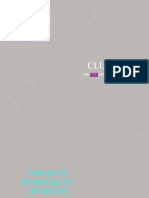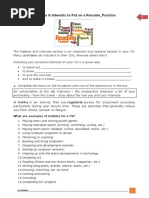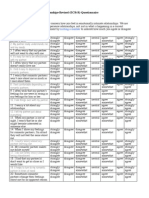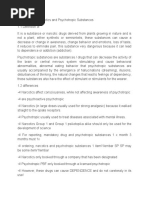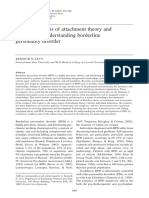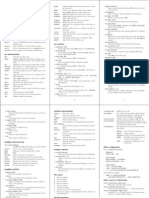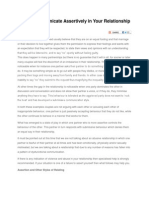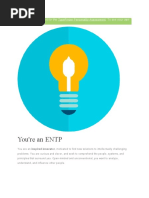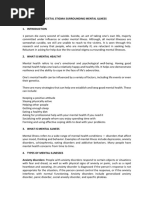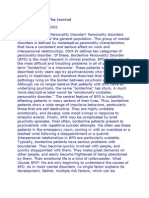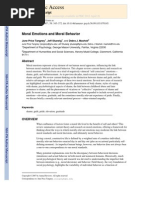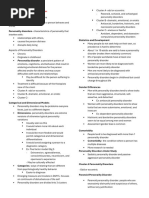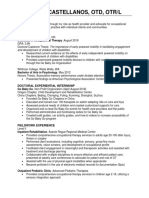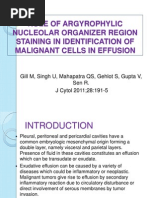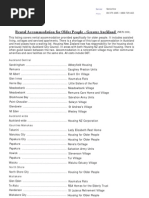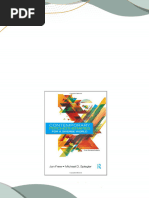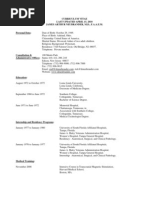100%(2)100% found this document useful (2 votes)
191 viewsPersonality Disorders
Personality Disorders
Uploaded by
Am-am PeñaflorThis document summarizes several personality disorders grouped into three clusters (A, B, and C). Cluster A disorders include schizotypal, schizoid, and paranoid personality disorders. Cluster B includes histrionic, antisocial, narcissistic, and borderline personality disorders. Cluster C comprises avoidant, dependent, and obsessive-compulsive personality disorders. Key features of each disorder are described briefly, including diagnostic criteria, prevalence rates, and common traits.
Copyright:
Attribution Non-Commercial (BY-NC)
Available Formats
Download as DOC, PDF, TXT or read online from Scribd
Personality Disorders
Personality Disorders
Uploaded by
Am-am Peñaflor100%(2)100% found this document useful (2 votes)
191 views4 pagesThis document summarizes several personality disorders grouped into three clusters (A, B, and C). Cluster A disorders include schizotypal, schizoid, and paranoid personality disorders. Cluster B includes histrionic, antisocial, narcissistic, and borderline personality disorders. Cluster C comprises avoidant, dependent, and obsessive-compulsive personality disorders. Key features of each disorder are described briefly, including diagnostic criteria, prevalence rates, and common traits.
Copyright
© Attribution Non-Commercial (BY-NC)
Available Formats
DOC, PDF, TXT or read online from Scribd
Share this document
Did you find this document useful?
Is this content inappropriate?
This document summarizes several personality disorders grouped into three clusters (A, B, and C). Cluster A disorders include schizotypal, schizoid, and paranoid personality disorders. Cluster B includes histrionic, antisocial, narcissistic, and borderline personality disorders. Cluster C comprises avoidant, dependent, and obsessive-compulsive personality disorders. Key features of each disorder are described briefly, including diagnostic criteria, prevalence rates, and common traits.
Copyright:
Attribution Non-Commercial (BY-NC)
Available Formats
Download as DOC, PDF, TXT or read online from Scribd
Download as doc, pdf, or txt
100%(2)100% found this document useful (2 votes)
191 views4 pagesPersonality Disorders
Personality Disorders
Uploaded by
Am-am PeñaflorThis document summarizes several personality disorders grouped into three clusters (A, B, and C). Cluster A disorders include schizotypal, schizoid, and paranoid personality disorders. Cluster B includes histrionic, antisocial, narcissistic, and borderline personality disorders. Cluster C comprises avoidant, dependent, and obsessive-compulsive personality disorders. Key features of each disorder are described briefly, including diagnostic criteria, prevalence rates, and common traits.
Copyright:
Attribution Non-Commercial (BY-NC)
Available Formats
Download as DOC, PDF, TXT or read online from Scribd
Download as doc, pdf, or txt
You are on page 1of 4
1PSYCHIATRY: PERSONALITY DISORDERS
PERSONALITY DISORDERS fixation at one psychosexual stage of
Cluster A Personality Disorders development. e.g. those with oral
• Also known as the odd and eccentric character are passive and dependent.
clusters While those of an anal character are
• These are exemplified by the stubborn, parsimonious and highly
following: conscientious because of struggle over
– Schizotypal personality toilet training.
disorder PARANOID P.D.
– Schizoid Personality disorder • Prevalence rate is 0.5 to 2.5% of the
– Paranoid personality disorder general population.
• They are characterized by long-
Cluster B Personality Disorders standing suspiciousness and mistrusts
• Also known as the dramatic, erratic of person in general. They refuse
and emotional responsibility of their own feelings and
• These are exemplified by the following assign responsibility to others. They
group are often hostile, irritable, and angry.
– Histrionic P.D. Bigots, injustice collectors,
– Antisocial P.D. pathologically jealous spouses, and
– Narcissistic P.D. litigious.
– Borderline P.D. • They are usually formal in manner,
usually serious and humorless.
Cluster C personality disorders • The essential feature is a pervasive
• Also known as the anxious and fearful and unwarranted tendency to interpret
cluster other person’s action as demeaning
• These are exemplified by the following or threatening.
– Avoidant • They usually dispute friend’s loyalty or
– Dependent trustworthiness.
– Obsessive-compulsive • This persons are pathologically jealous
and questions the fidelity of the
Genetic Factors spouse or sexual partners.
• All clusters have genetic basis • Their affect are usually restricted and
• Cluster A are more common in unemotional.
biological relatives patients with
schizophrenia than in control groups SCHIZOTYPAL PD
• Cluster B especially the antisocial P.D. • Persons with this PD are strikingly odd
is associated with alcohol use or strange even to laymen.
disorders. In borderline P.D., • Magical thinking, peculiar notions,
depression and mood disorder is ideas of reference, illusions and
common. Histrionic PD with derealizations are part of his daily
somatization disorder. world.
• Cluster C especially with Avoidant P.D. • They exhibit disturbed thinking and
have high anxiety levels. communicating
• They may be superstitious or claim
Psychoanalytic factors power of clairvoyance and believe
• Sigmund Freud suggested that they have special powers of thought
personality traits are related to a and insight. This is the premorbid
2PSYCHIATRY: PERSONALITY DISORDERS
personality of patient with thefts, fights, substance abuse and
schizophrenia. illegal activities
• Promiscuity, spousal abuse, child
SCHIZOID PD abuse and animal cruelty is common.
• Patients display a lifelong pattern of
social withdrawal Diagnostic Criteria
• They are introvert with constricted • Failure to conform with the social
affect. norms with respect to lawful behaviors
• They are often seen as eccentric, • Deceitfulness as indicated by repeated
isolated or lonely. lying, use of aliases or conning others
• Prevalence rate is about 7.5% of the for personal profit
general population. • Impulsivity or failure to plan ahead.
• Always cold and aloof; they display a • Irritability and aggressiveness by
remote reserve and show no repeated physical fights
involvement with everyday events and • Reckless disregard of safety of self or
the concerns of the others. others
• They are quiet, distant, seclusive, and • Consistent irresponsibility
unsociable • Lack of remorse
• They are the last to be aware of the • At least 18 years old
social fashion. • Presence of conduct disorder before
• The life histories of such persons age 15.
reflect solitary interests and success
at noncompetitive levels BORDERLINE PD
• Their sexual lives may exist • This PD stands on border between
exclusively at fantasy levels neurosis and psychosis.
• They are usually involved in • Almost always appear in the state of
nonhuman interests such as crisis.
astronomy and mathematics • Patients may have micropsychotic
episodes
ANTISOCIAL PD • They cannot tolerate being alone
• Is an inability to conform to the social • They consider each person as either
norms that ordinarily govern many all good or all bad.
aspects of adolescents and adult
• The defense mechanism is projective
behavior.
identification wherein the intolerable
• Constitute about 75% of the prison aspects of self are projected onto
population another.
• Patients usually appear composed and
credible Diagnostic Criteria
• There is usually tension, hostility, • Frantic efforts to avoid real or
irritability and rage. imagined abandonment
• They are usually charming and • Unstable and intense interpersonal
ingratiating relationship.
• They life histories revealed many • Identity disturbance markedly and
areas of life functioning such as lying, persistently unstable self image or
truancy, running away from home, sense of self.
3PSYCHIATRY: PERSONALITY DISORDERS
• Impulsivity that are potentially self • They consider themselves as special
damaging and expect special treatment
• Recurrent suicidal behavior or threats • They become enraged when criticized
or self mutilating behaviors • They can make other furious by their
• Affective instability due to marked refusal to obey conventional rules of
reactivity of mood behavior.
• Chronic feeling of emptiness
• Inappropriate, intense anger or AVOIDANT PD
difficulty in controlling anger. • Commonly described as persons with
• Transient stress related paranoid inferiority complex.
ideation • They show extreme sensitivity to
rejection and may lead to a socially
HISTRIONIC PD withdrawn life.
• They are excitable and emotional and • Hypersensitivity to rejection by others
behave in a colorful, dramatic, is the central feature.
extroverted fashion but unable to • Their main personality trait is timidity
maintain deep, long lasting • When talking with someone, they
attachments. expect uncertainty, show a lack of
• Usually cooperative and eager to give self-confidence, and may speak in self-
a detailed history. Gestures and effacing manner.
dramatic punctuations in their
conversations DEPENDENT PD
• They make frequent slips of the • They subordinate their own needs to
tongue and use colorful language those of others.
• They show a high degree of attention- • Get others to assume responsibility for
seeking behavior. major areas of their lives. Lack self-
• They display temper tantrums, tears confidence
and accusations when they are not the • Pessimist
center of attraction. • Fear of sexuality
• Seductive behavior is common on both • Self doubt
sexes • Passivity
• Woman maybe anorgasmic while men • Suggestibility
are impotent • Lack of perseverance
• Their need for reassurance is endless • Persons with this disorder cannot
• They may act on their sexual impulses make decisions without an excessive
to reassure themselves that they are amount of assurance or advice
attractive to other sex.
OBSESSIVE-COMPULSIVE PD
NARCISSISTIC PD • This is characterized by emotional
• They are characterized by heightened constriction, orderliness,
self-importance and grandiose feelings perseverance, stubbornness and
of uniqueness. indecisiveness.
• They have a grandiose sense of self- • A pervasive pattern of perfectionism
importance and inflexibility.
4PSYCHIATRY: PERSONALITY DISORDERS
• They are preoccupied with rules,
regulations, orderliness, neatness and
details.
• They cannot tolerate infractions
So, what is your personality disorder?
You might also like
- Stoma OsceDocument8 pagesStoma OsceRadhiyatul Ashiqeen Binti MoktarNo ratings yet
- The Treatment of Borderline Personalities With Rebt PDFDocument19 pagesThe Treatment of Borderline Personalities With Rebt PDFkancyNo ratings yet
- Behavior MGMT lp1Document3 pagesBehavior MGMT lp1api-242108732No ratings yet
- Ungar-Voices For Children Report - Resilient ChildrenDocument10 pagesUngar-Voices For Children Report - Resilient ChildrenChitulescu DianaNo ratings yet
- Coparenting Essay Final 12120Document16 pagesCoparenting Essay Final 12120api-533998164No ratings yet
- Middle Child Syndrome 2Document1 pageMiddle Child Syndrome 2tamakiusui18No ratings yet
- Bernard Gallagher Cap. 5 Sociology of Mental IllnessDocument16 pagesBernard Gallagher Cap. 5 Sociology of Mental IllnessLaura Cristina100% (1)
- IbuprofenDocument6 pagesIbuprofenOdyNo ratings yet
- Postpartum Care Plan New BornDocument10 pagesPostpartum Care Plan New BornUche Edwards-ShahidNo ratings yet
- Cluster A: The Odd and Eccentric ClusterDocument33 pagesCluster A: The Odd and Eccentric ClusteralEXISTNo ratings yet
- AssertivenessDocument9 pagesAssertivenessdaariyakhalidNo ratings yet
- Level 2 Depression AdultDocument3 pagesLevel 2 Depression AdultwaleskacrzNo ratings yet
- The Impact of REBT On AnxietyDocument11 pagesThe Impact of REBT On AnxietyMonica CiureaNo ratings yet
- Qualities of Good Son or DaughterDocument1 pageQualities of Good Son or DaughterThakor Joshi50% (2)
- SociopathDocument2 pagesSociopathIckai Marie Villaverde0% (1)
- Sources of Strength For Mental Wellness by Sheryl Boswell, Youth Mental Health Canada (YMHC)Document11 pagesSources of Strength For Mental Wellness by Sheryl Boswell, Youth Mental Health Canada (YMHC)Youth Mental Health CanadaNo ratings yet
- Bipolar Disorder in Adults - Assessment and Diagnosis PDFDocument15 pagesBipolar Disorder in Adults - Assessment and Diagnosis PDFdreamingNo ratings yet
- Schizophrenia: φρεν-; "mind"), schizophrenia does not imply a "split mind" and it is not the same asDocument3 pagesSchizophrenia: φρεν-; "mind"), schizophrenia does not imply a "split mind" and it is not the same asy3nkieNo ratings yet
- Hobbies Interests To Put On A Resume - TO PRACTISEDocument4 pagesHobbies Interests To Put On A Resume - TO PRACTISELucia CauhépéNo ratings yet
- Module 3 - Assessing and Diagnosing AbnormalityDocument33 pagesModule 3 - Assessing and Diagnosing Abnormalityxyryl ann mae capiliNo ratings yet
- Handout Chapter15Document3 pagesHandout Chapter15BismahMehdiNo ratings yet
- AND PerceptionDocument35 pagesAND PerceptionairaNo ratings yet
- Freud: The Psychoanalytic Approach To PersonalityDocument35 pagesFreud: The Psychoanalytic Approach To PersonalityAntriksh AgrawalNo ratings yet
- ECR PyetesorDocument2 pagesECR PyetesorJuna BeqiriNo ratings yet
- Gender Differences in Narcissism - A Meta-Analytic ReviewDocument52 pagesGender Differences in Narcissism - A Meta-Analytic ReviewBobi BadarevskiNo ratings yet
- Experimental Manipulation of NEO-PI-R ItemsDocument20 pagesExperimental Manipulation of NEO-PI-R Itemsltomic_1100% (1)
- Borderline Personality Disorder (BPD)Document16 pagesBorderline Personality Disorder (BPD)jessNo ratings yet
- Borderline Personality DisorderDocument16 pagesBorderline Personality DisorderRaissa100% (1)
- Avoidant Personality DisorderDocument9 pagesAvoidant Personality DisorderJenry Reyes TrispaNo ratings yet
- Sick PersonalityDocument4 pagesSick PersonalityAtul TyagiNo ratings yet
- SchizophrenieaDocument41 pagesSchizophrenieaSamba SukanyaNo ratings yet
- Differences in Narcotics and Psychotropic SubstancesDocument1 pageDifferences in Narcotics and Psychotropic SubstancesArihantAskiGoswamiNo ratings yet
- Poor-Sucker Syndrome The Story About Leeches and The Men That Feed Them A Self-Help, Self-Defense Book To Save Men. and A Get-Rich-Quick Guide For Women. by Vandell Mitch PDFDocument104 pagesPoor-Sucker Syndrome The Story About Leeches and The Men That Feed Them A Self-Help, Self-Defense Book To Save Men. and A Get-Rich-Quick Guide For Women. by Vandell Mitch PDFLuis VelasquezNo ratings yet
- Borderline Personality DisorderDocument9 pagesBorderline Personality DisorderSiva Nandhan0% (1)
- DSM distributed system management Complete Self-Assessment GuideFrom EverandDSM distributed system management Complete Self-Assessment GuideNo ratings yet
- Levy 2005Document28 pagesLevy 2005Daniela StoicaNo ratings yet
- Cluster BDocument3 pagesCluster BMegNo ratings yet
- Abnormal Psychology and TherapiesDocument1 pageAbnormal Psychology and TherapiesAra TanNo ratings yet
- Birth Order & IntelligenceDocument36 pagesBirth Order & Intelligencemoo2elynNo ratings yet
- Subversion Quick Reference CardDocument2 pagesSubversion Quick Reference CardSneetsher Crispy100% (3)
- Behavioural Problem Teennager: Family Medicine SystemDocument23 pagesBehavioural Problem Teennager: Family Medicine SystemSelvi Puspa SariNo ratings yet
- Psych GENDER IDENTITY DISORDERS TRANSDocument8 pagesPsych GENDER IDENTITY DISORDERS TRANSIsabel CastilloNo ratings yet
- Avoidance Personality Disorder #1Document4 pagesAvoidance Personality Disorder #1Angelo Provido0% (1)
- Birth Order TraitsDocument2 pagesBirth Order Traitsjay100% (1)
- Lecture No. 2 Semiology of Psychiatry Part 1Document33 pagesLecture No. 2 Semiology of Psychiatry Part 1ozgur.yonlukNo ratings yet
- Assertive CommunicationDocument8 pagesAssertive CommunicationNag28rajNo ratings yet
- Pid 5Document16 pagesPid 5Alpha NoirNo ratings yet
- True Finder Personality TestDocument44 pagesTrue Finder Personality TestMICHNo ratings yet
- Setting Professional BoundariesDocument22 pagesSetting Professional BoundariesRustam Koshelev100% (1)
- Borderline Personality Disorder - Wikipedia The Free Encyclope PDFDocument34 pagesBorderline Personality Disorder - Wikipedia The Free Encyclope PDFstephNo ratings yet
- Dyadic Adjustment ScaleDocument2 pagesDyadic Adjustment ScaleCPsych Ayesha MehmoodNo ratings yet
- PTS Presentation Group - 10Document29 pagesPTS Presentation Group - 10Aryan ruhelaNo ratings yet
- Research PaperDocument10 pagesResearch PaperParthGuptaNo ratings yet
- EthicsDocument9 pagesEthicsSourasish NathNo ratings yet
- Joel ParisDocument4 pagesJoel ParisJazeel JameelNo ratings yet
- Moral Emotions and Moral BehaviorDocument27 pagesMoral Emotions and Moral BehaviorCătălina PoianăNo ratings yet
- Working With Sex Offenders: Therapeutic Interactions & TechniquesDocument68 pagesWorking With Sex Offenders: Therapeutic Interactions & TechniquesDr. Anna C. SalterNo ratings yet
- System HackingDocument16 pagesSystem Hackingajrojas1359No ratings yet
- Personality DisordersDocument17 pagesPersonality Disordersleana nhalieNo ratings yet
- Chapter 12Document5 pagesChapter 12athercineNo ratings yet
- 7 Personality DisordersDocument39 pages7 Personality DisordersSaladin AbrahimNo ratings yet
- Personality DisorderDocument59 pagesPersonality Disorderdillasemera2014No ratings yet
- PersonalityDocument56 pagesPersonalitybarajaalalaa133No ratings yet
- Stages of ShockDocument1 pageStages of ShockRedhwan85No ratings yet
- NCP Proper - Obstructive JaundiceDocument8 pagesNCP Proper - Obstructive JaundiceWyen Cabatbat100% (2)
- Breathing ExercisesDocument4 pagesBreathing ExercisesHARIHARAN100% (1)
- The Influence of Family Relation To Academic Performance Among Grade 11 Students of ScpsDocument7 pagesThe Influence of Family Relation To Academic Performance Among Grade 11 Students of ScpsLiecel Ocampo0% (1)
- 64-Article Text-191-1-10-20190727Document11 pages64-Article Text-191-1-10-20190727Fina LisnaNo ratings yet
- Weebly ResumeDocument2 pagesWeebly Resumeapi-300073296No ratings yet
- Basic NLP Training ManualDocument67 pagesBasic NLP Training Manualmuveszszi100% (1)
- CP UpdatedDocument45 pagesCP UpdatedSivakumar Kathuu KarthikeyanNo ratings yet
- 03.partus Immaturus, Prematurus, SerotinusDocument60 pages03.partus Immaturus, Prematurus, SerotinusSuci Rahayu Evasha100% (2)
- Therapy Format I. Therapy: News Sharing Therapy Date: July 28, 2021 II. Materials/EquipmentDocument2 pagesTherapy Format I. Therapy: News Sharing Therapy Date: July 28, 2021 II. Materials/EquipmentAesthea BondadNo ratings yet
- 39 Fiori D Bach in Quadranti RadioniciDocument40 pages39 Fiori D Bach in Quadranti Radionicisabina111100% (3)
- Role of Argyrophylic Nucleolar Organizer Region Staining in Identification of Malignant Cells in EffusionDocument28 pagesRole of Argyrophylic Nucleolar Organizer Region Staining in Identification of Malignant Cells in EffusionDivya SethiNo ratings yet
- Rental Accommodation For Older PeopleDocument10 pagesRental Accommodation For Older PeoplenzdocNo ratings yet
- Age-Related Macular Disease: Fitriani Umi Hasanah 201820401011121 Pembimbing: Dr. Fatin Hamamah, SP.MDocument28 pagesAge-Related Macular Disease: Fitriani Umi Hasanah 201820401011121 Pembimbing: Dr. Fatin Hamamah, SP.MKim NayoungNo ratings yet
- Instant ebooks textbook Contemporary psychotherapies for a diverse world 1st rev. ed Edition Frew download all chaptersDocument77 pagesInstant ebooks textbook Contemporary psychotherapies for a diverse world 1st rev. ed Edition Frew download all chaptersnuzzoboschi7100% (1)
- PharmacologyDocument8 pagesPharmacologyjunalynNo ratings yet
- Vascular Disorders: Dr. Eri Siti Khoeriyah, SPPK, MkesDocument56 pagesVascular Disorders: Dr. Eri Siti Khoeriyah, SPPK, MkesYeni Jesika SilitongaNo ratings yet
- Title: Effects of Activity-Based Therapy Interventions On Mobility, Independence and QualityDocument55 pagesTitle: Effects of Activity-Based Therapy Interventions On Mobility, Independence and Qualityoscar eduardo mateus ariasNo ratings yet
- Aroma TherapyDocument4 pagesAroma Therapymuneeb zafarNo ratings yet
- Dorothy E. Johnson: Behavioral System ModelDocument15 pagesDorothy E. Johnson: Behavioral System Modelwickwax100% (1)
- Dental Management of Medically Complex Patients PDF-159Document159 pagesDental Management of Medically Complex Patients PDF-159hazeemmegahed100% (1)
- Curriculum Vitae, Updated April 15, 2010Document32 pagesCurriculum Vitae, Updated April 15, 2010Enne MiddNo ratings yet
- Mental Wellness: Rhea A. Lanzar, RGCDocument27 pagesMental Wellness: Rhea A. Lanzar, RGCRhea Lanzar100% (1)
- Symptoms: Cyanide Toxicity Is Often Associated With The Odor of Almonds On BreathDocument2 pagesSymptoms: Cyanide Toxicity Is Often Associated With The Odor of Almonds On BreathRyan PanNo ratings yet
- Acute Ischemic Stroke DrugsDocument45 pagesAcute Ischemic Stroke DrugsDamar TriutomoNo ratings yet
- Nursing Prioritization and NCP (Bataan)Document7 pagesNursing Prioritization and NCP (Bataan)Rudy Mark ReyesNo ratings yet
- Conflict, Negotiation and ConsensusDocument127 pagesConflict, Negotiation and Consensusarthianand100% (3)









